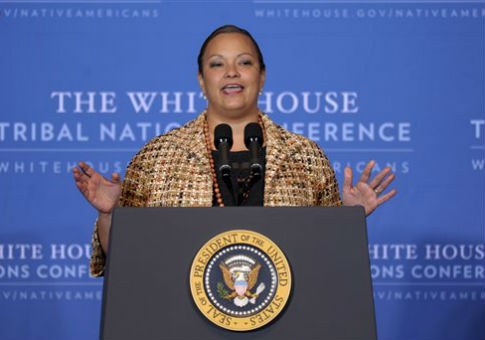An environmental consulting firm that has secretly worked behind the scenes to support Environmental Protection Agency regulations released a study on Wednesday declaring one of the agency’s most controversial regulations sound.
M.J. Bradley & Associates released an analysis of the EPA’s regulations on carbon emissions from existing power plants on Wednesday. The consulting firm concluded that the regulations are "very achievable," a key metric that could determine their validity in the face of ongoing legal challenges.
"This comprehensive analysis shows that, by various pathways, the Clean Power Plan's carbon pollution reduction goals are very achievable," Christopher Van Atten, a vice president at the firm, said of the study.
The analysis comes as a federal court weighs whether to suspend implementation of EPA’s power plant regulation. Twenty-seven states, which are responsible for ensuring compliance with its emissions targets, are suing to block the rule altogether.
Federal regulations must be achievable—the government cannot place impossible burdens on those it regulates—and the states and industry groups suing the EPA say the 111(d) rule, as the power plant regulation is known, is simply too stringent.
The firm’s study is an effort to mitigate those concerns.
"The nation's electricity sector can significantly reduce carbon dioxide emissions," Van Atten insisted in a statement on the firm’s analysis.
Though the firm presented the study as dispassionate scientific analysis, emails show that its top executives have for years worked behind the scenes with senior EPA officials to build support for its regulations, and that the EPA has counted on the firm to be a public voice for its power plant rule specifically.
According to a 2012 email from Lisa Jackson, then the head of the EPA, the agency considered the firm one of the key industry "validators" for its power plant regulations. The email was sent under the pseudonym Richard Windsor, which Jackson used to send messages from a personal account that was initially shielded from public records laws
According to Nick Conger, an EPA spokesman, the agency designates groups as validators when it anticipates they "will provide validation or support for the action that the agency is taking." Jackson herself identified the Clean Energy Group, an advocacy outfit run by the firm, as one such group.
In off-the-record emails, EPA staffers referred reporters to Michael Bradley, the firm’s founder and president, and Jessica Morey, the Clean Energy Group’s project director, for stories on the agency’s power plant regulations.
The firm also helped senior EPA policy staff to craft talking points for a meeting with the utility giant Exelon, according to another email.
Chris Horner, a senior fellow at the Competitive Enterprise Institute who obtained the emails through requests under the Freedom of Information Act, said that the EPA’s behind-the-scenes work with the firm compromises the objectivity of its findings on 111(d)’s achievability.
"Pieced together [the emails] tell a story, clearly. In short, the remarkably close relationship at high levels of EPA activists … with Michael J. Bradley and his client on whose behalf he performs these works of wonder, the Clean Energy Group," Horner wrote in an email.
"This represents the next shoe to drop in the story about EPA’s unlawful work to generate an echo chamber" to support its regulations, he said.
Neither M.J. Bradley & Associates nor the EPA responded to a request for comment on this story. Conger said that the EPA’s interactions with the group were standard practice.
"EPA conducted unprecedented outreach during development of the Clean Power Plan, engaging with a wide range of stakeholders with a variety of opinions on the rule," he wrote in an emailed statement. "It’s common practice to anticipate stakeholders’ reactions prior to issuing an action that may affect them."
Horner’s Energy and Environment Legal Institute has filed briefs in the lawsuit seeking to block EPA’s power plant rule. The group claims that the EPA did not disclose the extent of environmental groups’ roles in crafting the rule.
A key player in the institute’s argument is Michael Goo, a former EPA policy chief who led early agency efforts to craft power plant regulations.
Emails show that Goo frequently communicated with Bradley on power plant regulations and other EPA rules. "Let me know if there’s anything we can do to assist with the inside game," Bradley told Goo in a December 2011 email.
By that time Bradley and Goo, who was a senior official at the Natural Resource Defense Council before joining the EPA in early 2011, were also strategizing on the 111(d) rule.
"To the extent possible, it may make sense to release the proposal after mid-November in order to try to mitigate the backlash on the other EPA air regulations," Bradley wrote in a September 2011 email discussing EPA’s release of the proposed rule to industry groups.
"It would also be good to find some time in the next few weeks to discuss with you the issues CEG has been evaluating for existing units under 111(d)," Bradley wrote.
At the time, Goo was coordinating with staff at NRDC and the Sierra Club, who advised him to massage legal language in order to justify the implementation of carbon regulations stringent enough that they would result in the closure of numerous coal-fired power plants.
One Sierra Club official suggested altering the EPA’s definition of "remaining useful life" in order to write off coal plant closures.
"EPA can … establish a performance standard for existing plants that is not achievable by any plant nearing the end of its ‘remaining useful life’ as defined by EPA," giving the agency leeway to force plant closures while still maintaining that the rule is "achievable."
